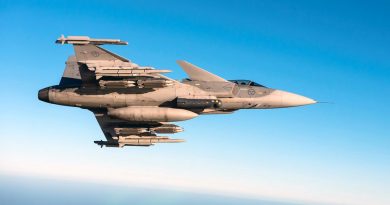
LIMA 2025 – Diehl promotes its Coastal Defence Launcher
At the LIMA 2025 exhibition in Langkawi, Diehl Defence is presenting the mock-up of its Coastal Defence Launcher system, an innovative coastal defence solution designed to meet modern naval threats. This modular, mobile launcher is designed to provide effective protection of coastal areas by integrating new-generation anti-ship missiles on land-based platforms tailored to the needs of armed forces

Diehl Defence’s Coastal Defence Launcher is designed to provide an advanced anti-ship capability for denial of access and sea area control. Modular and mobile, the system can be rapidly deployed to protect coastlines against naval threats.
It typically consists of a Mobile Sensor Unit (MSU) equipped with a surface search radar and electro-optical/infrared (EO/IR) sensors on telescopic masts, a Mobile Control Unit (MCU) with several operator consoles, several Firing Units (FU), and mobile maintenance and reloading units depending on operational requirements.
Each Firing Unit integrates on a single vehicle a containerised module for mission electronics and the inclined launch ramp that carries up to four anti-ship missiles. The launcher is designed for versatility and can accommodate different types of missiles. Among these the Saab RBS15 Mk3 missile developed in partnership with Diehl Defence. This long-range anti-ship missile, designed and produced jointly by the two companies, is specifically integrated on truck-mounted launcher modules for modern coastal defence systems.
The RBS15 Mk3 is powered by a turbojet, features a range in excess of 200 km, flies at Mach 0.9, and carries a blast/fragment warhead with a mass of around 200 kg. Mass at launch, with boosters, is 820 kg, while in flight the missile has a mass of 660 kg. It is capable of adaptive sea-skimming to evade enemy defences and is designed to operate in complex maritime environments and difficult climatic conditions. It can be launched from land trucks, as in the case of coastal battery use, as well as from naval and air platforms.
This missile features multimodal guidance navigation, combining inertial navigation (INS) and GPS for precision in degraded environments. It has active radar homing in the terminal phase, capable of discriminating targets in maritime clutter. The missile has an infrared (IR) sensor for final identification and resistance to electronic countermeasures.

The RBS15 Mk3 has significant tactical adaptability in its ability to modify its trajectory in flight to bypass defences or prioritise secondary targets. Its sea-skimming flight profile at less than 3 metres above the sea complicates detection.
It is designed to operate in areas with a high density of enemy sensors, with a salvo firing logic to saturate defence systems. It is fitted with electronic countermeasures (ECCM) to maintain the lock despite jamming.
This missile is used in the new Swedish and German coastal defence systems, where it is integrated into mobile launcher modules developed by Diehl Defence.
The strengths of this system are its modularity and versatility (multi-missile compatibility), its high mobility and rapid deployment, its advanced sensors for detection and targeting, and its ability to operate in a network with several firing and detection units. It is designed to provide effective coastal protection against modern naval threats, with a flexible architecture tailored to the needs of armed forces.
These capabilities make it a formidable system against modern fleets protected by advanced electronic warfare systems, as demonstrated in recent NATO evaluations.
Photos by J. Roukoz


